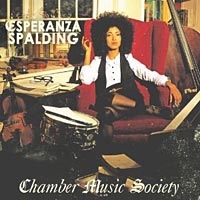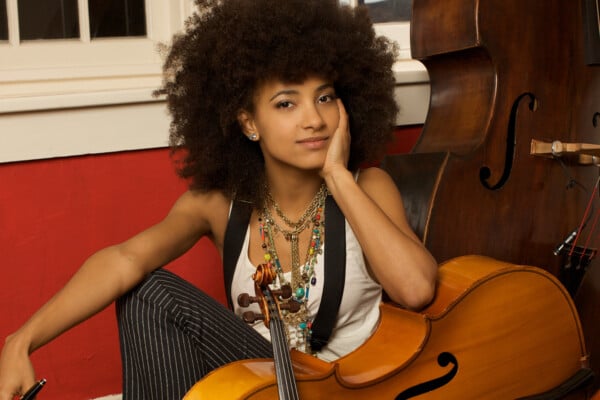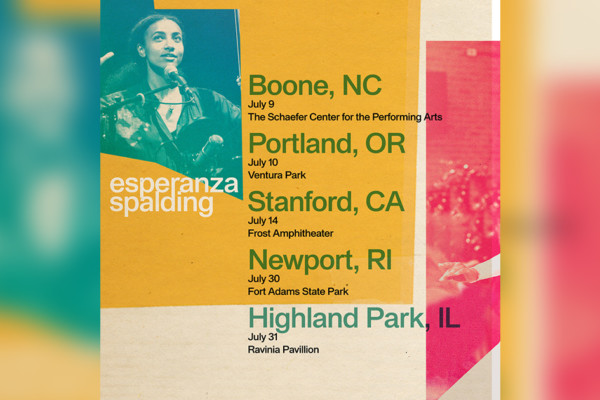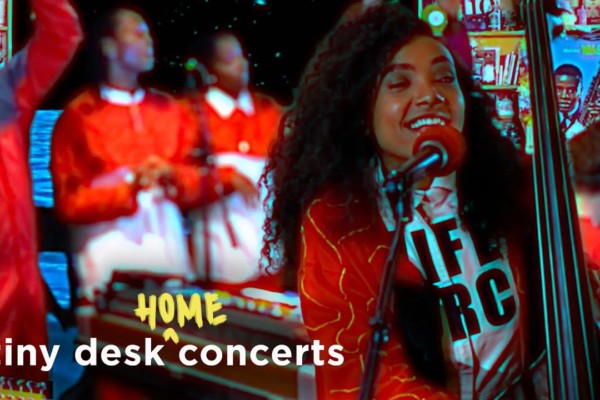A Review of Esperanza Spalding’s “Chamber Music Society”
 Esperanza Spalding‘s Chamber Music Society is a unique and beautiful record by a brilliant musician. Not what some might have expected, it’s fusion of jazz and chamber music with Brazilian overtones. Esperanza is known as a fine bassist – and she is that – but she is also a wonderful singer and a composer with a great musical mind. The music here is centered around fabulous string arrangements by Gil Goldstein combined with Spalding’s voice and upright bass, and with some fine support from piano, drums and other instruments. There are astounding combinations, arrangements that explore the sonic and emotional effects of different musical texture, sympathetic players and wonderful compositions and improvisation.
Esperanza Spalding‘s Chamber Music Society is a unique and beautiful record by a brilliant musician. Not what some might have expected, it’s fusion of jazz and chamber music with Brazilian overtones. Esperanza is known as a fine bassist – and she is that – but she is also a wonderful singer and a composer with a great musical mind. The music here is centered around fabulous string arrangements by Gil Goldstein combined with Spalding’s voice and upright bass, and with some fine support from piano, drums and other instruments. There are astounding combinations, arrangements that explore the sonic and emotional effects of different musical texture, sympathetic players and wonderful compositions and improvisation.
I must admit I was pretty late to the party. I am known to be allergic to hype and when Esperanza’s face appeared all over the music magazines, I was a little wary. Listening to her music proved to me the buzz around her is undoubtedly based on her talent rather than her gender and youthfulness. She is destined to be one of greatest musicians of her generation.
Portland native Esperanza had a bilingual upbringing in Spanish and English, but it’s her love affair with Brazilian music that adds such depth to her music. Immediate and accessible, her music is also challenging and thought provoking. Her soprano vocal soars and leaps over the music and draws us into her world. Her singing voice is foremost here, her musical approach to bass supports the songs wonderfully. Her easy virtuosity contributes to a musical whole rather than grabbing the attention.
Goldstein’s string arrangements are masterful and add multi-layered textures to the songs here and the string trio play expressively and exquisitely throughout. Terri Lyne Carrington demonstrates why she’s one of the finest drummers of her generation, Leo Genovese’s piano adds depth and jazz authenticity and Quintino Cinalli’s percussion is an integral part of the musical textures. Gretchen Parlato’s voice is similar in timbre to Spalding’s, and the two intertwine at times to beguiling effect.
“Little Fly” sets out the record’s approach. William Blake’s poem is set to music by Spalding in a quiet, melodic piece. Arranged for voice, double bass and string trio, it opens with her spacious pizzicato line over which the strings and her voice soar. The texture of her voice perfectly complements the strings and her deep toned bass counterpoint. The arrangement is quite fabulous and Spalding gets to take a short bass solo to bring the tune to it’s conclusion.
“Knowledge of Good and Evil”, inspired by the Old Testament creation story is led by a wordless vocal that just blows me away. The track features the full band plus strings and is an intense, rolling rhythmic flight. It’s a contemporary jazz feel with staccato strings and expressive free-wheeling scat building over dramatic rolling drums and springy, expansive piano. It’s a compelling track that shifts between moods well.
“Really Very Small” is an intricate theme featuring intertwining, wordless vocals and contrasting time signatures. Rhythmically taut as a drum skin, it features a vocal melody in 6/8 over a 7/8 groove so seamlessly and naturally you’d never know. It packs a lot in less than three minutes.
“Chacarera” has a slow, Brazilian-influenced lilt to it and dancing melody that has a touch of what I imagine as Flora Purim singing with Hermeto Pascoal. The drums and percussion create a lovely relaxed groove and the string arrangement is a piece in itself.
“Wild is the Wind” is the masterpiece. A dramatic, almost theatrical take on the tune made famous by David Bowie. It was written for the 1957 film of that name and originally recorded by Johnny Mathis and Nina Simone of course had her own notable take on it. This is very much Spalding’s take on it, although Gil Goldstein’s masterful arrangement is worthy of mention. It’s an unusual line up: light drums, bass ostinatos, strings, Genovese’s gorgeous melodica and delicate piano and an astounding vocal performance. The opening is lush and spacious and developed by the expressive strings. Spalding’s light, high vocal imbues the lyrics with depth and expression; she lives it. Her voice sends shivers down my spine. After the spacious, atmosphere, a rollicking simple quarter note tango riff enters and further builds the tension about three quarters of the way in, enhanced with some fabulous string playing.
“Apple Blossom” is an unusual folk-like duet with Milton Nacimento featuring the two singing over Brazilian acoustic guitar and Goldstein’s string arrangement. The story is told as an epic ballad. The strings manage to add depth to a very simple song without taking over. It’s a special performance and Nascimento is inspired to some richly colored falsetto as the two’s voices dance around each other. The last chord is a gem.
“As a Sprout” is a tiny piece showcasing the strings and prefaces “What a Friend” featuring a slow relaxed, jazz ballad theme with Parlato and Spalding soaring on wordless vocals and some splendid bass counterpoint. Midway through, the piece briefly switches gear to a fast paced latin feel and the two feels alternate from then on with Genovese’s electric piano dancing joyously over the supple bass and drum groove.
“Winter Sun” has lyrics sung by Spalding over a lovely rhythmic groove, jazz ostinatos and vocal harmonies. There is a fabulous rollicking bass solo with a tremendous rhythmic bounce. Esperanza is such a natural all around musician with such a clear vision of her music. The tune is rounded out by an exciting, tumbling piano solo. Carrington’s drumming is quite captivating here the way the bass, piano and drums shape time together is remarkable. An inspiring performance.
“Inútil Paisagem”, the Jobim tune, is another favorite of mine, beginning with a vocal percussion duet reminiscent of Zap Mama. The track is performed using the lush vocal melodies, clicking sounds and calls over a beautiful sparse bass. Again, Spalding’s affinity for Brazilian music is clear for all to hear.
“Short and Sweet” ends the album. Piano, strings and Carrington’s sensitive drumming join Spalding’s bass in creating a lush ballad sound for her to sing over. Her double bass solo here is lyrical and intense leading into a poignant piano solo from Genovese. The drumming on this track is a wonder in itself and the ensemble performance creates a sustained dreamlike mood on which to end the album.
I had a while to live with this record. (Thanks to the people at Heads Up, I have had this record since May.) I loved it from the outset and have listened to it a lot and it’s that kind of record: one you will return to often. Esperanza is a special talent. This is a woman who taught herself to play violin in a year to a standard high enough to play in an orchestra, a woman who won a place at University at 16, and who was appointed as an instructor at Berklee at 20! Her journey so far has included gigs with Michael Camilo, Stanley Clarke, Pat Metheny, Patti Austin and Joe Lovano and has been invited to perform for President Obama. One can only wonder where that journey might take her.
Esperanza is a wonderful talent, don’t be late to the party!
Credits:
- Esperanza Spalding: double bass, vocals
- Entcho Todorov: violin
- Lois Martin: viola
- David Eggar: cello
- Terri Lyne Carrington: drums
- Leo Genovese: piano, melodica, keyboards
- Gretchen Parlato: vocals
- Richard Vogt: guitar
- Milton Nascimento: vocals
- Quintino Cinalli: percussion
- Gil Goldstein: string arrangements
Preview and Download Chamber Music Society:
Chamber Music Society is available today from Amazon.




I have listened to the previews of the Cd and as soon as I can I will be adding it to my music library. I love her voice and the way she expresses herself on the upright. Love the video for “Little Fly”. Mr. Blake would be proud.
There’s another preview video at:
http://www.youtube.com/watch?v=uk-oJGAXSjA
Actually Phil, “Chacarera” is not a Brazilian groove. It’s a Chacarera, a groove from the “Pampas”, the country side of Argentina (which it’s where Leo’s from) and it has nothing to do with Brazilian music.
Brazilian music is mostly based on a 2/4 16th note feel, whereas Chacareras are on the 3 or 6/8 triplety side of things.
Listen to his band from Boston (Leo Genovese and los cromaticos gauchos) and you’ll know what I’m talking about.
But Espe’s music’s bigger than all this stuff, she’s not trying to be Argentine or Brazilian, She’s trying to be music.
Thanks Amanda, Leo wrote that too. I know nothing of Argentinian music so thanks for that.
Leo’s a fascinating musician. I only found out later that he wrote Chacacera. His website is http://www.leogenovese.com/ Really worth buying this CD to hear how Leo and Esperanza play together. A special mention for Gretchen Parlato’s singing on the record which is wonderful and complements Esperanza’s voice and music very well.
chacarera is Argentina!
Yes, I stand corrected on that. I was pointed out in the comments below. It reminded me of something Hermeto Pascoal might have done and I was not familiar with Argentinian music beyond Tango.
ok, I hope you have not taken the wrong way, and also hope you will understand what I’m writing because I’m using the google translator, jijiji.
No, of course not. Thank you for the correction. I like to learn about music from around the world. I have played Ghanaian, Turkish, Bulgarian, Klezmer, Reggae, Hawaiian, Rebetiko, Samba etc and I should definitely check out more Argentinian music.
[…] no trebleI had a while to live with this record. I loved it from the outset and have listened to it a lot and it’s that kind of record: one you will return to often. Esperanza is a special talent. […]